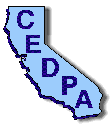
 |
California Educational Data Processing Association |
The DataBus - Vol. 37, No. 3
|
The California Community Colleges (CCC) received funding in the 1996-97 fiscal year to assure that each of its 106 campuses and 19 administrative centers establish necessary infrastructure capability for connection to the Internet, video conferencing and satellite downlink. CSUnet was identified as the provider for Internet services. The Community Colleges Chancellor's Office is coordinating the video conference and satellite downlink efforts.
The CSU and CCC have subsequently established a collaborative relationship to create 4Cnet, the California State University and California Community Colleges Network. 4CNet is an expansion of CSUnet which was established in 1984 by the California State University (CSU) system as a dedicated data network linking each of the campuses of the CSU. The network was created as one of several efforts to meet the increasing information technology demands of the University system and its campuses throughout the State. The addition of the Community Colleges to the network will afford both systems a resource to serve their academic and administrative mission, goals and objectives in ways that exploit centralized and distributed information resources.
4Cnet will provide a T-1 data connection from each community college site to a node on the 4Cnet backbone. The 4Cnet backbone is designed using ATM and DS-3 connections between each of ten network nodes placed at CSU campuses and administrative centers throughout the state. The planning and design of the new network includes the interconnection of high speed circuits throughout the state from Pacific Bell, General Telephone and TCG. The primary telecommunications equipment is from FORE for the Asynchronous Transfer Mode switches at the hub sites and from Cisco for the hub and individual site routers. Installation of 4Cnet sites will begin the first week in April and it is expected that all participating Community College sites will be completed as early as the end of the 1997 calendar year.
The preliminary model for connection of community college sites called for individual connections to 4Cnet for each campus. As the planning for the project progressed, many of the 19 multi-site community college districts expressed a desire to serve as hubs for their constituent campuses in order to better fit with district-wide technology plans. Consequently, many of those 19 districts have been identified as 4Cnet hub sites and will be provided with a higher level of service such as multiple T-1 connections and larger routers. The districts will in turn provide connections to their constituent campuses. Such a model not only provides Internet connection for campuses, but of equal importance makes use of or enhances the intra-district communications network.